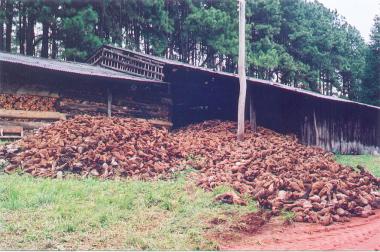"Nó de Pinho" ( stands
for"Araucaria-Pinetree-Knots"
) as the most excelent natural
firewood, is found so
far, exclusively in Brazil.
They are normally sold in 10
Kg - 15 kg bags.
.
The
"knots",
heavy pieces of "resin-impregnated-conic-shaped-wood",
during many centuries resisted
decay under the soil,
long after the large stems (which originated
them), were naturally decomposed.
These KNOTS (intersection of branches
to their stems) remained unchanged on the
graund. Actually can solely be disintegrated
by fire.
Their sizes vary. any of them big or small,
burn excelently.
.
B A C K
Their flame last for
hours. Wise users, save
the precious knots
mixing them up with Eucalyptus
or Pinetree-firewood. |
 |
Every
year they become more scarce. We may anticipate
that in a decade or so the "Nó de Pinho" shall not be
available anymore. The ones presently used are
remnants of "centuries'-old-Araucaria-trees".
Origin:
During centuries those huge Araucaria-trunks kept
falling to the ground, eventually struck by
lightning, fires etc. (one may
say also through "aging" - end of life cycle)
Nowadays,
while
plowing,
farmers finding them under the ground, collect the
knots, pile them up, thus providing an "additional
income", selling them as fire-wood.
.
Since
thousands of years the Brazilian South
East coast was covered by the "Atlantic Forest"
(
Brazilian designation for Native forests along the
Atlantic ). Particularly in the brazilian
Southern States: Paraná, Santa Catarina, Rio Grande
do Sul, Sao Paulo and Minas Gerais, the dominant
specie was the ARAUCARIA, designated "Pinheiro
do Paraná" - araucaria angustifolia and araucaria
brasiliensis.
| .
These
trees
in the past reached up to 52 meters height
and their trunk up to 8,5 meters
circumference. The cones are shaped like a
ball with over 30 cm diameter and provide
seeds averaging 6 cm length. (These
are edible ! Boiled, some butter and salt
added, are a real delicious 'TREAT'). |
 |
.
.
The
lumber industry (thousands of saw-mills) exploited
these Araucaria forests to exhaustion (mainly for
export). That "saw-mill-boom" provided
at the time thousands of jobs. Is lasted until last
century (mid 1950's)
Brazilian
authorities nowadays protect the natural
forests, particularly the Araucarias.
Presently the cutting of any Araucaria, as well
as any native tree, requires a special permit. |




